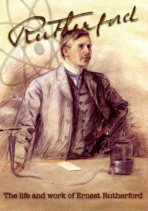Letizia Diamante reviews a three-part documentary on the life and work of Ernest Rutherford
 Professor Radium, the Atom Splitter, the Crocodile. Each is a nickname pointing to Ernest Rutherford, who made history by explaining radioactivity, discovering the proton and splitting the atom. All his scientific and personal milestones are described in great detail in the three-part documentary Rutherford, produced by Spacegirls Production Ltd in 2011.
Professor Radium, the Atom Splitter, the Crocodile. Each is a nickname pointing to Ernest Rutherford, who made history by explaining radioactivity, discovering the proton and splitting the atom. All his scientific and personal milestones are described in great detail in the three-part documentary Rutherford, produced by Spacegirls Production Ltd in 2011.
Accompanied by physics historian John Campbell, the viewer learns about this great scientist from his ordinary childhood as a “Kiwi boy” to his untimely death in 1937. Historical reconstructions and trips to the places (New Zealand, the UK and Canada) that characterised his life bring Rutherford back to life.
When it was still heresy to think that there existed objects smaller than an atom, Rutherford was exploring the secrets of the invisible. During his first stay in Cambridge (UK), he discovered that uranium emits two types of radiation, which he named alpha and beta. Then, continuing his research at McGill University (Canada), he discovered that radioactivity has to do with the instability of the atom. He was rewarded with the Nobel Prize in Chemistry in 1908, and called Professor Radium after a comic book character of that name. In those years, people did not know the effects of radiation and “radio-toothpaste” was available to buy.
Then in Manchester (UK), he conducted the first artificial-induced nuclear reaction and described a new model of the atom, where a proton is like a fly in the middle of an empty cathedral. He fired alpha particles at nitrogen gas and obtained oxygen plus hydrogen, thus the epithet of the world’s first “atom splitter”.
In-between these big discoveries, the documentary points out that Rutherford blew tobacco smoke into his ionisation chamber, providing the groundwork for modern smoke detectors, proposed a more accurate dating system for the Earth’s age based on the rate of decay of uranium atoms, and campaigned for women’s opportunities and saving scientists from war.
The name “Crocodile” came later, from soviet physicist Pyotr Kapitza, as it is an animal that never turns back – or perhaps a reference to Rutherford’s loud voice that preceded his visits. The carving of a crocodile on the outer wall of the Mond Laboratory at the Cavendish site, commissioned by Kapitza, still reminds Cambridge students and tourists of this outstanding physicist.
- Spacegirls Production Ltd





